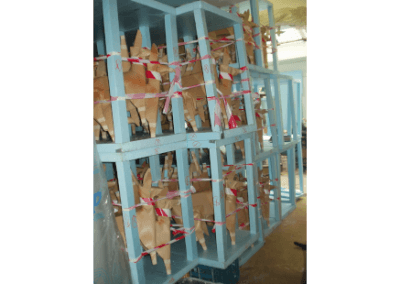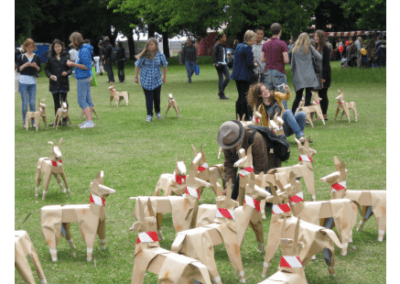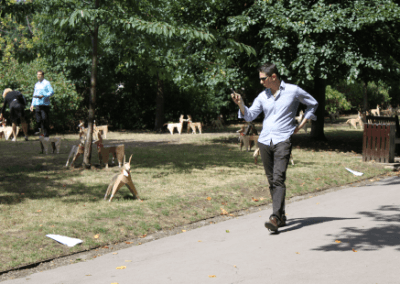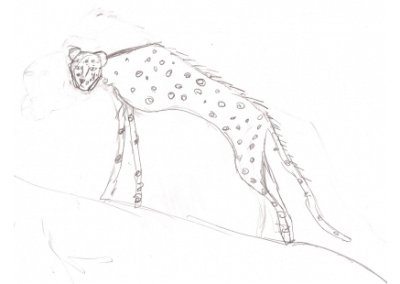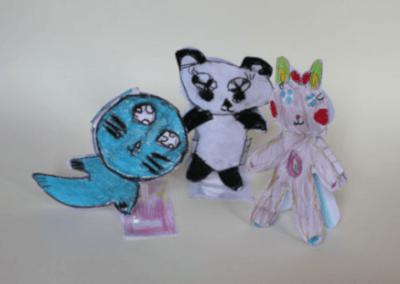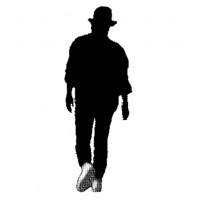DOGLondon2010
DOGLondon2010. This is the story of Akane Takayama’s award-winning DOG Sculpture Installation in London in 2010. A groundbreaking work based on very simple concepts but involving many layers, not least possibly the first intrinsic use of Social Media as a fundamental element of the installation long before “selfies” were ever a vogue. Ostensibly a simple work, DOG is a complex construction delivering a raft of outcomes for the communities involved. Takayama’s vision of conceptual contemporary art potentially being a vehicle for community expression and redefining it beyond the world of wealthy patronage and the institution of galleries is realised in her DOG sculptures.
This web page tells the story of an astonishing contemporary art sculpture and how it impacts on communities.
Note: estimated audience figures are based on the numbers of the leaflets handed out on the day.
Akane Takayama conceived of her DOG installation in 2008 when she found the model of a dog in a waste skip in the back streets of central London. The model itself was a cheap, poorly constructed item and its forlorn position in the rubbish of society attracted her to ideas of value and how we place a value on the material world around us. She started work in her studio in Hackney, East London, looking at a design and structure of a work of contemporary public art. In this process, she evaluated the materials and the structure, considered the idea of creating an iconic form and then producing it in such numbers that the size and extent of the sculpture would create a memorable impact.
The installation at Victoria Park, East London, was the first DOG sculpture. For once, the weather was pleasant and the audience engaged with the work over two days. the popularity of this public art work was immediate and when the end of each day came, Takayama’s team were hard pressed handing the DOGs out.
estimated audience 1600
Clissold Park, Stoke Newington, London was the second installation venue of the DOG sculpture. This park provided large expansive vistas in which long lines of DOGs created an impressive sight over a large area. The audience had the benefit of a wonderful sunny day in which to walk amongst the installation and participate in public art.
estimated audience 600
Holland Park, Knightsbridge, London was the third installation in the DOGLondon2010 production. The venue was slightly different because rather than an expansive display area, at Holland Park DOG found itself in the splendid entrance avenue which leads into the park.
estimated audience 1200

Takayama’s team set up the installation under her guidance. During the course of the installation, they marshalled the site and gave out leaflets which explained what the work was all about. The team engaged with the audience and helped them to really engage with the work. At the end of each day, the team then distributed the DOGs to those who wanted them and managed the clear up of the site.



DOGLondon2010
Takayama’s concept of providing a truly accessible contemporary art installation included the idea of giving away for free the DOGs at the end of each installation. This was tied into her idea that the whole concept of DOG would move from the physical to the virtual space of digital media. The internet was to be the gallery for her DOG sculpture work. In 2010, this was an innovatory move and the popularity and dominance of the phenomenon of ‘selfies’ did not at that moment really exist. However, at every installation, people were using their new smart phones to capture images of themselves with the DOGs.
On handing out the DOGs, the team talked to the audience about the desire of the artist that they pose their DOGs in their own artistic constructs and post their images online. In this way, Takayama’s desire to see the audience participation evolve beyond the physical installation into their own creative expression was realised.

A search of ‘DOG by Akane Takayama’ brings up an extensive online gallery of this work and draws in images from other works by Takayama. A range of search terms around DOG, sculpture, installation, Akane Takayama, London, also produces impressive results. As can also be seen in the image above, sponsors and funders have their own logos drawn into this gallery.
The delivery of the DOG sculpture was universally praised for its professional approach and it is a credit to Takayama’s team that the logistics were managed to timetable. In this video some of the story of DOG and its journey to the parks of London is told.
Conceptually Takayama envisaged DOG to be an artwork which engaged not just people but a community. Whilst the primary statement about the sculpture was concerning how people value the material things in their lives, this participation of other people was seen as an act of engagement intrinsic to the purpose of the artist. Takayama wanted to create a contemporary sculpture which people could not just approach but become part of through their own interactions.
The sculpture itself was used as a mechanism to engage with the younger members of community and encourage and promote their own personal creativity. Takayama did not want to ‘use’ children to make her work, she as an artist, felt strongly about her own authorship of the work, but she believed DOG had the power to inspire. As a result, she created a workshop concept for delivery into primary schools, which taught the children how to make three-dimensional models.
Having prepared the schedule, operational timetable and methods to be employed in her Workshop Guide, she presented it to schools across London. In all 19 primary schools took up her offer and she delivered workshops into all of those schools. They started with a first drawing of an animal they would like to create in three dimensions. The beauty of Takayama’s entire approach was that she was not insisting on the content of the work. This meant that the participating schools could tie the workshop models into a part of their syllabus delivery. Each school picked the topic or theme of the workshop to match the pedagogic agenda delivered to the pupils in that year.
Takayama’s workshops in the schools ran for one day. The teachers had been provided with a workshop pack in which she had laid out the timetable for the workshop and a detailed, step by step, illustrated, task flow. Sometimes single handedly, sometimes with members of her team, Takayama would work with the children and guide them through each stage to the production of their own models.
“The children thoroughly enjoyed working with you to create their animals and were incredibly engaged throughout the entire experience.” Comment by UK School Teacher.
In the hundreds of three-dimensional models which were produced, there are some stunning examples of both creativity and comprehension. Takayama’s purpose was to release the creative ability of the children and to help them understand their own potential to be artists. She talked with the children about what it meant to be an artist, how it is a career, and how her studio worked. Finally, she took the kid’s models away and arranged public installations for their work.
At the end of the workshops the children were asked to write a message of hope for the future. All of the Year 4 pupils from the 19 primary schools involved completed their messages.
These were then taken to the DOG installations and inserted into a flap at the back of the DOGs neck. In this way, Takayama had brought the children into the main sculpture and provided a connection for them with DOG and on to the audience.
These messages ranged from expressions of hope for world peace, calls to stop bullying and crime and hopes for a healthy environment. Amongst this range every now and again the idiosyncratic would appear such as the wish for a socialist government!
As the schools involved were mostly in deprived areas of London there was an obvious expression of cultural diversity within the messages which make this aspect of the work open to many sorts of sociological investigation.
At the heart of these messages is clearly the innocence of childhood, and this quality became even more apparent when the audience engaged with the messages at the installations.


In many ways it appeared that, on reading the messages, there was a question about how it is our growth into adulthood separates us from the open aspirations and simple ideas we have when we are young.

Takayama’s huge vision with the DOG work included providing the children with their own public exhibitions of their work. She felt very strongly that the pedigogical aim of inspiring young people both with their creativity and their artistic ambitions would not simply be completed in a workshop. In setting up public installations of the children’s work, she gave the opportunity for the young people, many from deprived backgrounds, to see their own work in the context of their communities as public art work.
The venues were libraries and museums, public venues, and this gave the chance for the children to bring their families to their own “exhibitions”. In this action there was an opportunity for these young people to feel a sense of achievement and their own personal value within their communities.







